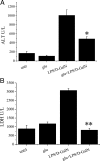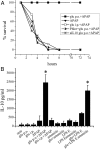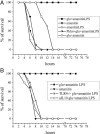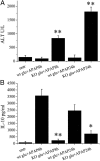Intestinal glucose uptake protects liver from lipopolysaccharide and D-galactosamine, acetaminophen, and alpha-amanitin in mice
- PMID: 19700751
- PMCID: PMC2731125
- DOI: 10.2353/ajpath.2009.090071
Intestinal glucose uptake protects liver from lipopolysaccharide and D-galactosamine, acetaminophen, and alpha-amanitin in mice
Abstract
We have recently observed that oral administration of D-glucose saves animals from lipopolysaccharide (LPS)-induced death. This effect is the likely consequence of glucose-induced activation of the sodium-dependent glucose transporter-1. In this study, we investigated possible hepatoprotective effects of glucose-induced, sodium-dependent, glucose transporter-1 activation. We show that oral administration of D-glucose, but not of either D-fructose or sucrose, prevents LPS-induced liver injury, as well as liver injury and death induced by an overdose of acetaminophen. In both of these models, physiological liver morphology is maintained and organ protection is confirmed by unchanged levels of the circulating markers of hepatotoxicity, such as alanine transaminase or lactate dehydrogenase. In addition, D-glucose was found to protect the liver from alpha-amanitin-induced liver injury. In this case, in contrast to the previously described models, a second signal had to be present in addition to glucose to achieve protective efficacy. Toll-like receptor 4 stimulation that was induced by low doses of LPS was identified as such a second signal. Eventually, the protective effect of orally administered glucose on liver injury induced by LPS, overdose of acetaminophen, or alpha-amanitin was shown to be mediated by the anti-inflammatory cytokine interleukin-10. These findings, showing glucose-induced protective effects in several animal models of liver injury, might be relevant in view of possible therapeutic interventions against different forms of acute hepatic injury.
Figures












Similar articles
-
Hepatoprotective effect of α-mangostin against lipopolysaccharide/d-galactosamine-induced acute liver failure in mice.Biomed Pharmacother. 2018 Oct;106:896-901. doi: 10.1016/j.biopha.2018.07.034. Epub 2018 Jul 12. Biomed Pharmacother. 2018. PMID: 30119260
-
Pretreatment with Salvia miltiorrhiza Polysaccharides Protects from Lipopolysaccharides/d-Galactosamine-Induced Liver Injury in Mice Through Inhibiting TLR4/MyD88 Signaling Pathway.J Interferon Cytokine Res. 2019 Aug;39(8):495-505. doi: 10.1089/jir.2018.0137. Epub 2019 May 10. J Interferon Cytokine Res. 2019. PMID: 31074668
-
Protective effects of ginsenoside Rg1 against lipopolysaccharide/d-galactosamine-induced acute liver injury in mice through inhibiting toll-like receptor 4 signaling pathway.Int Immunopharmacol. 2018 Aug;61:266-276. doi: 10.1016/j.intimp.2018.06.008. Epub 2018 Jun 11. Int Immunopharmacol. 2018. PMID: 29902710
-
Propofol attenuates inflammatory response and apoptosis to protect d-galactosamine/lipopolysaccharide induced acute liver injury via regulating TLR4/NF-κB/NLRP3 pathway.Int Immunopharmacol. 2019 Dec;77:105974. doi: 10.1016/j.intimp.2019.105974. Epub 2019 Nov 15. Int Immunopharmacol. 2019. PMID: 31735662
-
Protective effects of morin on lipopolysaccharide/d-galactosamine-induced acute liver injury by inhibiting TLR4/NF-κB and activating Nrf2/HO-1 signaling pathways.Int Immunopharmacol. 2017 Apr;45:148-155. doi: 10.1016/j.intimp.2017.02.010. Epub 2017 Feb 14. Int Immunopharmacol. 2017. PMID: 28213269
Cited by
-
Intestinal Epithelial Chemokine (C-C Motif) Ligand 7 Overexpression Enhances Acetaminophen-Induced Hepatotoxicity in Mice.Am J Pathol. 2020 Jan;190(1):57-67. doi: 10.1016/j.ajpath.2019.09.009. Epub 2019 Oct 11. Am J Pathol. 2020. PMID: 31610172 Free PMC article.
-
Adenosine 5'-monophosphate ameliorates D-galactosamine/lipopolysaccharide-induced liver injury through an adenosine receptor-independent mechanism in mice.Cell Death Dis. 2014 Jan 9;5(1):e985. doi: 10.1038/cddis.2013.516. Cell Death Dis. 2014. PMID: 24407238 Free PMC article.
-
Investigation of Gynura segetum root extract (GSrE) induced hepatotoxicity based on metabolomic signatures and microbial community profiling in rats.Front Microbiol. 2022 Aug 9;13:947757. doi: 10.3389/fmicb.2022.947757. eCollection 2022. Front Microbiol. 2022. PMID: 36016788 Free PMC article.
-
Galactose protects hepatocytes against TNF-α-induced apoptosis by promoting activation of the NF-κB signaling pathway in acute liver failure.Lab Invest. 2015 May;95(5):504-14. doi: 10.1038/labinvest.2015.34. Epub 2015 Mar 9. Lab Invest. 2015. PMID: 25751739
-
ASS and SULT2A1 are Novel and Sensitive Biomarkers of Acute Hepatic Injury-A Comparative Study in Animal Models.J Liver. 2013 Jan 10;2(1):1000115. doi: 10.4172/2167-0889.1000115. J Liver. 2013. PMID: 23724364 Free PMC article.
References
-
- Schiodt FV, Antillasoy E, Shakil AO, Schiff ER, Caldwell C, Kowdley KV, Stibling R, Crippin JS, Flamm S, Somberg KA, Rosen H, McCashland TM, Hay JE, Lee WM. Etiology and outcome for 295 patients with acute liver failure in the United States. Liver Transpl Surg. 1999;5:29–34. - PubMed
-
- Dass M, Plevak DJ, Wijdicks EF, Rakela J, Wiesner RH, Piepgras DG, Dunn WF, Steers JL. Acute liver failure: results of a 5-year clinical protocol. Liver Transpl Surg. 1995;1:210–219. - PubMed
-
- Luedde T, Trautwein C. Intracellular survival pathways in the liver. Liver Int. 2006;26:1163–1174. - PubMed
-
- Palazzo M, Gariboldi S, Zanobbio L, Selleri S, Dusio GF, Mauro V, Rossini A, Balsari A, Rumio C. SGLT-1 as a novel immunological player in the intestinal mucosa. J Immunol. 2008;181:3126–3136. - PubMed
MeSH terms
Substances
LinkOut - more resources
Full Text Sources
Medical
Molecular Biology Databases

